Red Laser Diode | 630nm-690nm / 5mW(CW)-4.2W(Pulse)
Red laser diodes are used in a wide variety of applications such as display & entertainment, medical & healthcare, life science, sensing & measurement, and printers due to their high optical output power, high efficiency, excellent beam quality, and high reliability. In recent years, they have also begun to be applied in AR/VR, quantum technology, and automotive applications.
Ushio offers a lineup of red laser diodes with the world's highest level of performance and reliability based on device design technology, crystal growth technology, and microfabrication technology cultivated over 40 years.
Displays & Entertainment
Ushio have been continuously developing and commercializing red high-power multi-mode LDs for cinema projectors, home projectors, and laser TVs. Most recently, we have added the HL63680HD to our product lineup, which achieves the world's highest pulsed optical output power of 4.2W and wall-plug efficiency of 45%. This product will contribute to the spread of laser projectors.
World's Highest Level 638nm 4.2W Pulse/ 3W CW Red High Power Laser Diode HL63680HD
IL Characteristics
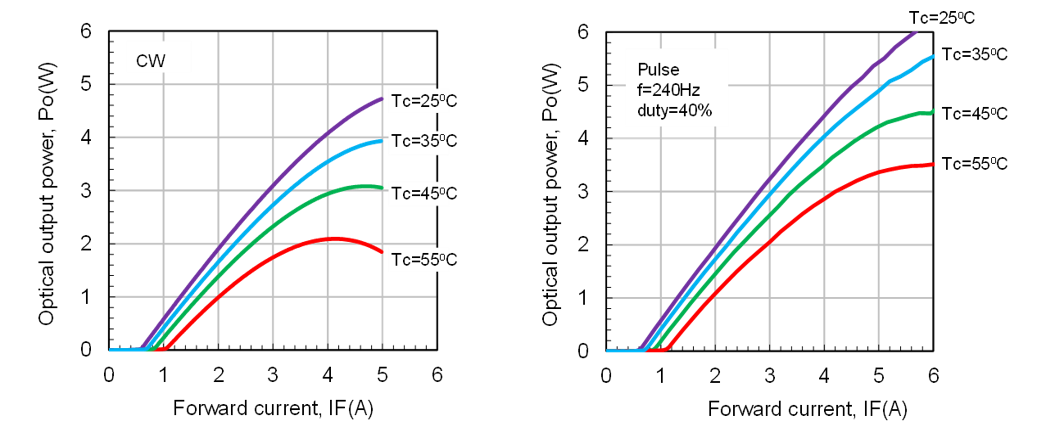
Medical & Healthcare, Life Science
Ushio's single-mode LDs have excellent beam quality and high reliability, and are used in many instruments including analytical instrument. In addition, We has recently added 1.2W high power multi-mode LD series in the red wavelength band (630 to 690nm) to its product lineup to meet the specific wavelength requirements of photodynamic therapy and skin treatment. These products will contribute to the improvement of QOL in the medical and healthcare fields.
1.2W high power multi-mode LD series in the red wavelength band 630 to 690nm corresponding to specific wavelengths required for photodynamic therapy and skin treatment
Example of Spectrum Shape
(Tc=25℃,Po=1.2W)
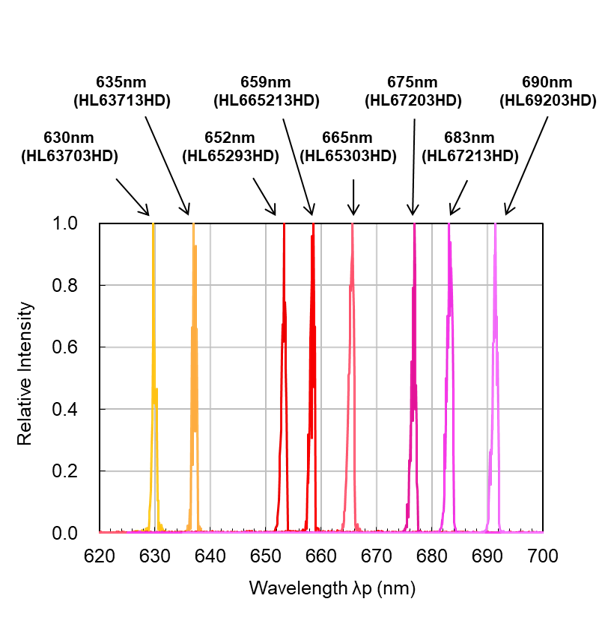
Sensing & Measurement
The HL65261MG series of 660nm band 300mW short-pulse high-power LDs with nanosecond or shorter pulse response are designed for TOF (Time of Flight) laser distance sensor applications used in factory automation (FA) of manufacturing lines and automation and unmanned operation of logistics systems. This product contributes to the expansion of distance measurement length and improvement of distance measurement accuracy.
HL65261MG series, 660nm band 300mW short-pulse high-power LDs that respond in nanoseconds or less
Example of pulse response waveform
(Pw=10ns, duty=10%, Po=20mWp-p, Ith bias)

The HL63642DG series, a 640-nm band 200-mW LD with wide temperature operation, high optical output power, and low power consumption, is also available for leveler applications used to draw horizontal and vertical reference lines at construction sites. This product has a wide operating temperature range from low to high temperatures (operating temperature -40℃ to 60℃) and can be used in harsh environments, while contributing to lower power consumption and longer battery life of devices.
HL63642DG series, 640nm band 200mW LDs with wide temperature operation, high optical output power and low power consumption
Example of IL characteristics
(CW)
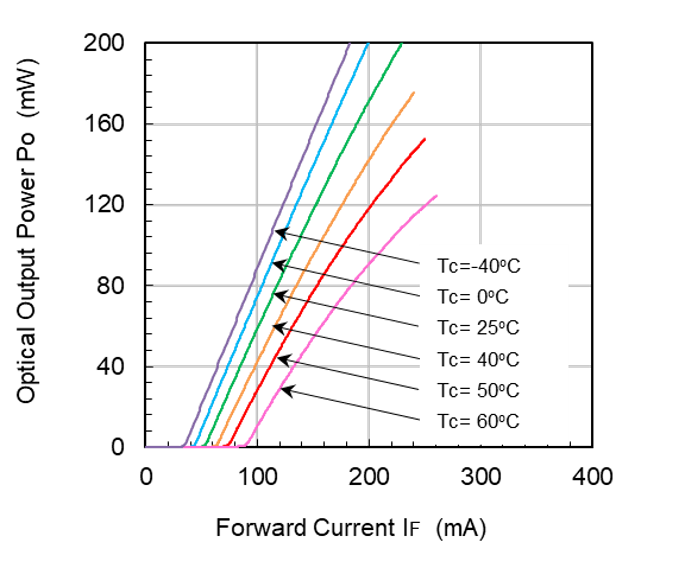
Quantum technology
By applying the device design and crystal growth technologies cultivated in the development of 640nm red high-power single-mode LDs, we have developed a lineup of 200mW high-power single-mode LDs in the 670-705nm red wavelength range that lasing at a specific wavelength suitable for quantum technologies (optical lattice clocks, laser cooling, etc.). These products will contribute to the development of quantum technology.
Red wavelength 670-705nm band 200mW high power single-mode LD series for specific wavelengths for quantum technology
Example of Spectrum Shape
(Tc=25℃,Po=200mW)
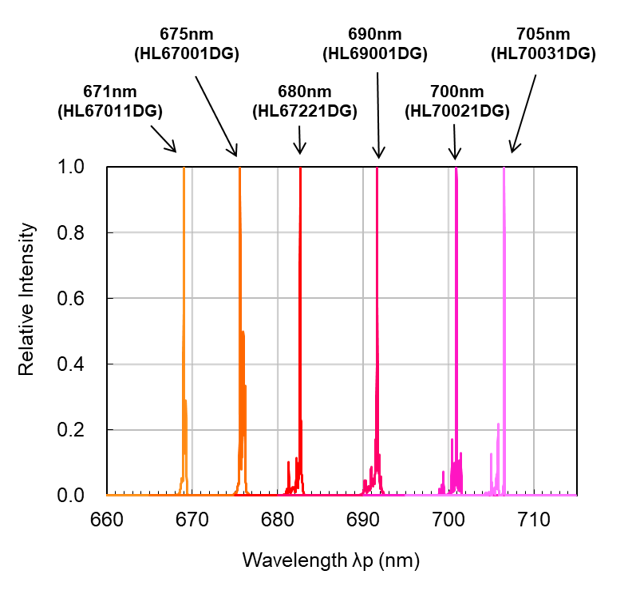
Automotive
LDs have a wide range of applications in automotive systems, including headlights with blue LDs, LiDAR with near-infrared LDs, taillights with red LDs, head-up displays (HUD) with RGB LDs, in-vehicle projection, and welcome lights. Research and development is being conducted extensively in each of these fields, and some of them are being put to practical use. Ushio is working on the development of red high-power single-mode LDs that can operate at high temperatures, which is ideal for these applications. In particular, operation at the high temperature of 85℃ required for automotive applications has been considered difficult for red 640nm band LDs due to a number of technical issues, but by further optimizing the chip structure, Ushio has succeeded in significantly improving performance compared to conventional products, achieving 50mW optical output power operation at 85℃.
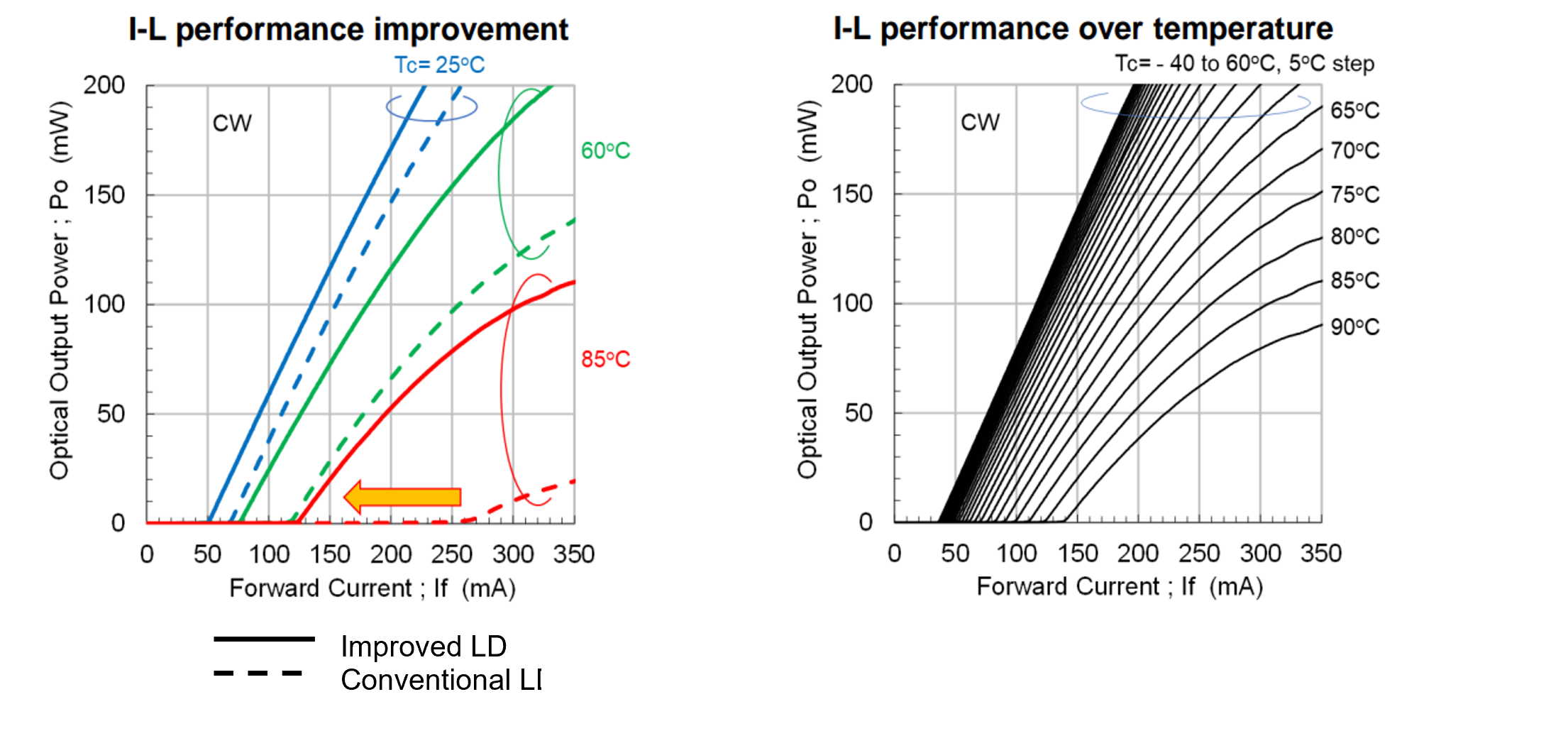
AR/VR
With the advancement of augmented reality (AR)/virtual reality (VR) technology, the market is expected to expand in the future as it is being used in various business domains, including the entertainment industry, such as games, as well as the manufacturing and medical fields. Ushio offers a lineup of low to high light output, high efficiency and low power consumption red LDs with single transverse mode for AR smart glasses. Optical modules for AR/VR devices such as smart glasses and head-mounted displays require optimum package design and miniaturization, so we can also supply LD chips. Please contact our sales office for purchase terms and conditions when purchasing LD chips.
News Link
Academic Conference
"USHIO 3.5W red laser diode for projector light source"
Proc. SPIE 10939, Novel In-Plane Semiconductor Lasers XVIII, 109391I (1 March 2019);
https://doi.org/10.1117/12.2507834
"Single-mode 200mW 660nm to 690nm red laser diode for sensing and medical application"
Proc. SPIE 11301, Novel In-Plane Semiconductor Lasers XIX, 1130105(24 February 2020);
https://doi.org/10.1117/12.2543953
"Red laser diodes explore the future of biomedical and quantum technology"
Proc. SPIE 12440, Novel In-Plane Semiconductor Lasers XXII; 124400M (15 March 2023)
https://doi.org/10.1117/12.2648284
"Red laser diode development for automotive applications"
Proc. SPIE 12905, Novel In-Plane Semiconductor Lasers XXIII; 1290502 (13 March 2024)
https://doi.org/10.1117/12.3002826
